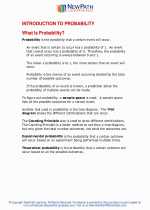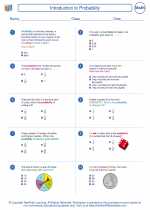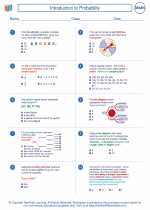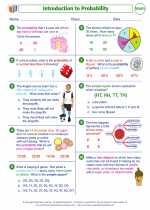Introduction to Probability -> sum
Sum
In mathematics, the sum is the result of adding two or more numbers or quantities together. The sum is a basic arithmetic operation and is denoted by the plus sign (+). For example, the sum of 3 and 5 is 8, which can be written as 3 + 5 = 8.
Properties of Sum
- Commutative Property: The sum of two numbers remains the same regardless of the order in which they are added. In other words, a + b = b + a.
- Associative Property: When adding three or more numbers, the grouping of the numbers does not affect the sum. In other words, (a + b) + c = a + (b + c).
- Identity Property: The sum of any number and zero is the number itself. In other words, a + 0 = a.
Examples
1. Find the sum of 7 and 4.
Sum: 7 + 4 = 11
2. Find the sum of 12, 5, and 8.
Sum: 12 + 5 + 8 = 25
Study Guide
To effectively work with sums, it's important to understand the basic properties and practice adding different numbers. Here are some key points to remember when dealing with sums:
- Understand the meaning of the sum and how it relates to addition.
- Learn and apply the commutative, associative, and identity properties of addition.
- Practice adding single-digit, double-digit, and triple-digit numbers to build fluency in finding sums.
- Apply the concept of sums to real-life situations, such as adding prices of items or calculating total distances traveled.
By mastering the concept of sum and practicing its application, you'll develop a strong foundation in arithmetic and be better equipped to solve more complex mathematical problems in the future.
.◂Math Worksheets and Study Guides Seventh Grade. Introduction to Probability
Study Guide Introduction to Probability
Introduction to Probability  Worksheet/Answer key
Worksheet/Answer key Introduction to Probability
Introduction to Probability  Worksheet/Answer key
Worksheet/Answer key Introduction to Probability
Introduction to Probability  Worksheet/Answer key
Worksheet/Answer key Introduction to Probability
Introduction to Probability  Worksheet/Answer key
Worksheet/Answer key Introduction to Probability
Introduction to Probability 

 Worksheet/Answer key
Worksheet/Answer key
 Worksheet/Answer key
Worksheet/Answer key
 Worksheet/Answer key
Worksheet/Answer key
 Worksheet/Answer key
Worksheet/Answer key

The resources above cover the following skills:
Data Analysis and Probability (NCTM)
Understand and apply basic concepts of probability
Use proportionality and a basic understanding of probability to make and test conjectures about the results of experiments and simulations.
Connections to the Grade 7 Focal Points (NCTM)
Probability: Students understand that when all outcomes of an experiment are equally likely, the theoretical probability of an event is the fraction of outcomes in which the event occurs. Students use theoretical probability and proportions to make approximate predictions.